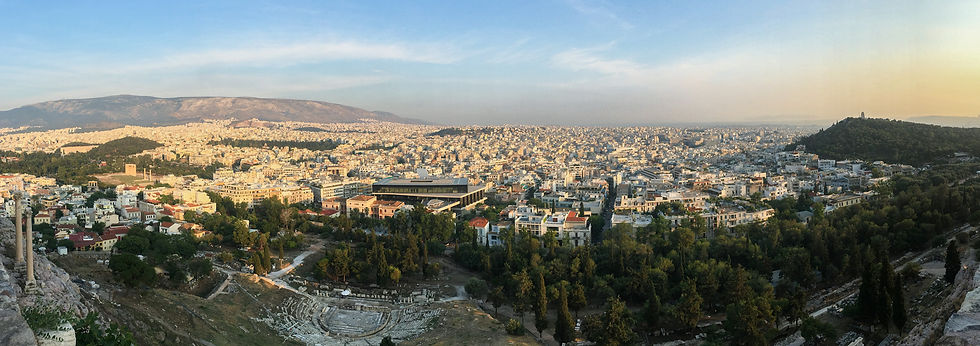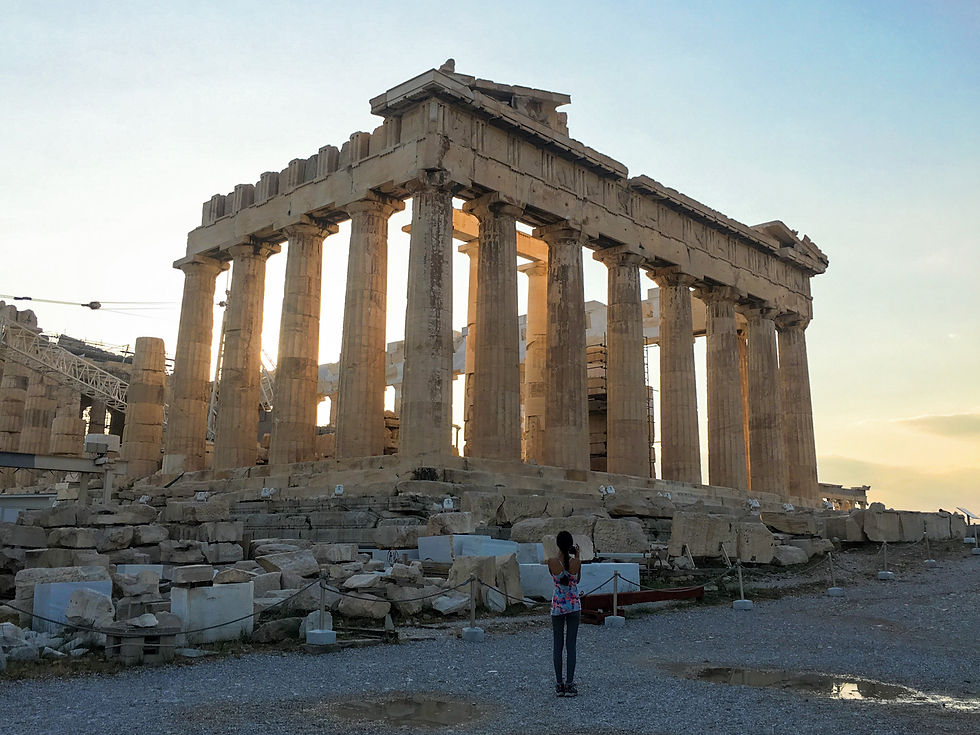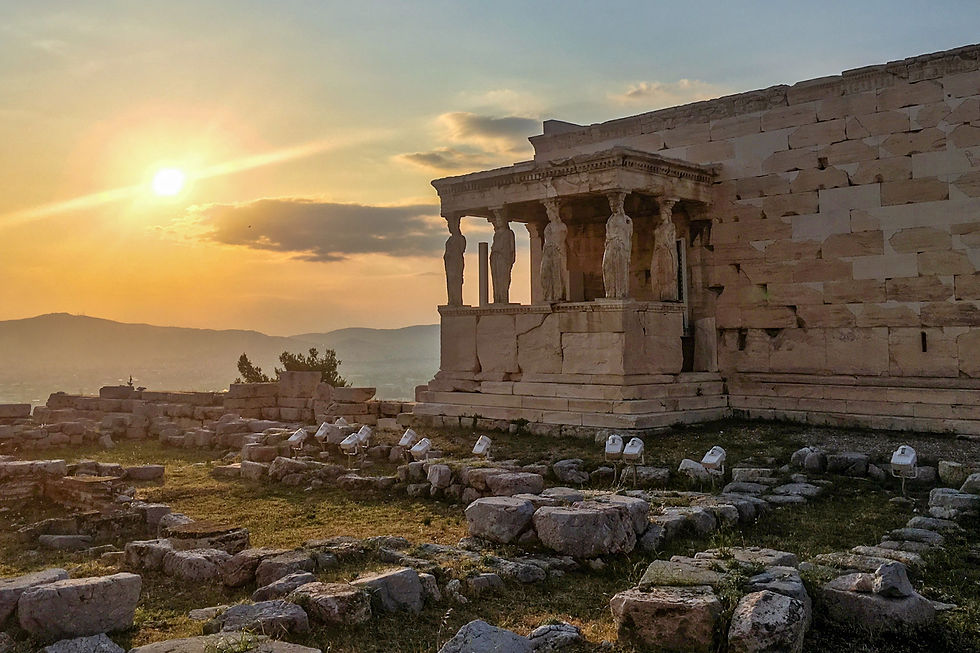The Perfect 2 Weeks in Greece - Our Complete Road Trip Itinerary
- Eryn

- Feb 6, 2023
- 9 min read
Updated: Feb 8, 2023

With its incredible ancient history and beautiful natural landscapes, Greece is a world-famous destination and one of the most visited countries on Earth. When you imagine Greece, a picture perhaps not unlike the photo above might come to mind—the soft hues of traditional whitewashed buildings forming an idyllic island paradise in the Mediterranean. These scenes that seem too good to be true do come alive on islands like Santorini, but Greece has so much more to offer! You'll find secluded monasteries perched atop giant rock columns in Meteora, see ancient ruins intertwined with the natural scenery in Delphi, and experience the old magnificently crashing into the new in Greece's capital city of Athens. On our two-week road trip that took us down central Greece and brought us island-hopping to Santorini and Crete, we truly saw the best of Greece.
The Itinerary at a Glance
Days 1 & 2 – Thessaloniki
Day 3 – Halkidiki
Days 4 – Meteora
Days 5 – Delphi
Days 6-8 – Santorini
Days 9 & 10 – Heraklion
Days 11-13 – Athens
The Itinerary Day by Day
Day 1 - Arrive in Thessaloniki

A port city on the Aegean Sea, Thessaloniki is the second largest city in Greece and is full of history. Thessaloniki was founded in 315 BC by Cassander, king of Macedon, who named the city after his wife, the sister of Alexander the Great. Strategically located by the sea, Thessaloniki prospered as a commercial center and naval base of the Macedonian Kingdom. The city continued to flourish under the Ancient Roman and Byzantine empires, and in 1430, it was conquered by the Ottoman Empire until 1912. With its legacy, Thessaloniki retains its commercial importance and multicultural vibrance to this day. It also preserves architectural remains from each of the great empires it was controlled by, making the city an incredible historical and cultural destination.
We arrived in Thessaloniki on our first day in Greece and settled into the city where we would spend the next 3 nights. We also picked up our rental car for the first leg of our trip which would take us down through the incredible sights and landscapes of the central Greek mainland. But before we get ahead of ourselves, it's time to explore Thessaloniki!
Day 2 - Thessaloniki

After arriving in Thessaloniki on Day 1, we devoted Day 2 to exploring the unique port city.
Among its landmarks, Thessaloniki's most famous symbol is the White Tower. It stands in the place of a Byzantine fortification that dated back to the 12th century. You can walk up the tower and as you follow the spiraling tunnel upwards, you can explore the different museum exhibits that the tower houses. Once you reach the very top, you'll get to enjoy sprawling views of Thessaloniki and the Aegean Sea flanking it.
To see the remnants of Thessaloniki's rich history, we visited the Archaeological Museum of Thessaloniki, one of the largest museums in Greece. To travel more specifically back in time to the age of the Byzantine Empire, we also explored the Museum of Byzantine Culture which features exhibitions of the civilization's unique art and artifacts.
Day 3 - Day Trip to Halkidiki

After spending two days exploring Thessaloniki, we took a day trip to Halkidiki which is only a 2-hour drive away from the city. Known for its “Three Fingers,” Halkidiki is a region in Northern Greece featuring three peninsulas that are indeed shaped like fingers. Check out the map at the beginning of this post, and you'll see they look a lot more like fingers than you might initially think! Stretching out into the Aegean Sea, Halkidiki boasts untouched natural landscapes–in particular, white-sand beaches and crystal-clear turquoise water. We drove down Halkidki's westernmost "finger" to Possidi Beach and the drive was just as, and if not more, beautiful than the destination itself! It's the perfect quick getaway from the bustle of Thessaloniki before you leave the seaside and begin traveling inland into central Greece.

Day 4 - Drive to Meteora

After three days of being based in Thessaloniki, it comes time to bid goodbye to the Second City of Greece. Next, we made the 3-hour drive west to Meteroa. Located in central Greece at the edge of the plains of Thessaly, this UNESCO World Heritage Site is unmistakable. The sheer cliff faces make the rocks seem like massive pillars, and to this day, they support the structures of centuries-old Eastern Orthodox monasteries that balance precariously atop them. We spent Day 4 getting to and settling into the nearby small town of Kalabaka where we stayed for the night, waiting in anticipation to see the incredible sanctuaries.
Day 5 - Meteora & Drive to Delphi

On Day 5, we woke up bright and early to explore the secluded monasteries of Meteora. Standing atop the pillars of rock with the clouds draped overhead, it was almost like visiting a lost city in the sky.
Click here for more on our journey into Meteora's monasteries!
After our time in Meteora came to a close, we made the 3-hour drive south from Meteora to Delphi which is tucked in the slopes and valleys formed by Mount Parnassus in central Greece.
Having been considered the very center of the world and one of the most sacred sites in Ancient Greece, Delphi is surrounded by history, mysticism, and archaeological wonders. Its temples and structures are thousands of years old and are the actual settings of Greek myths and historical figures. In particular, it was the home of the famed Oracle of Delphi who, serving as a bridge between humans and the gods, often changed the course of history itself with her prophecies.

Once we arrived in Delphi, we started at the Archaeological Museum of Delphi located at the entrance of the archaeological site where it holds the many treasures that were excavated from the nearby ruins. After seeing its preserved artifacts, we then hiked into the ruins of the Sanctuary of Apollo where most of Delphi's ancient structures lie. In Delphi, you will find yourself trekking amidst the remnants of a bygone civilization that are intertwined with the soft colors of the surrounding nature, rock cliff faces, and lush greenery.
After seeing this half of the ruins that make up Delphi (there's still more!), we headed back to the nearby town to get some rest for the second half.
Day 6 - Delphi, Drive to Athens & Fly to Santorini

Having visited the Archaeological Museum of Delphi and the Sanctuary of Apollo the previous day, this morning was dedicated to visiting the icon of Delphi, the Sanctuary of Athena Pronaia. It is home to the Tholos of Delphi, the remains of a circular building supported by columns. Surrounded by the natural scenery of the area and the beautiful ruins of the tholos, this quickly became the highlight of our visit to Delphi. It was the perfect send-off as we made our way to our next destination.
Click here to see more of the history and grounds of Delphi!

Our next stop was the one and only island of Santorini. It's unmistakable. The island's curving, whitewashed buildings that mold into the volcanic cliffscape and of course, its iconic blue-domed churches are the subject of every postcard from Greece. As it turns out, Santorini is dazzlingly just like the postcards but is also filled with hidden gems from its quieter sides, all the more adding to the idyllic island's charm. It's an icon you can't miss on a trip to Greece.
To get there, we made the 2.5-hour drive from Delphi to Athens. Then from Athens, it came time to say goodbye to the Greek mainland—at least for now—and we took a 1-hour flight to Santorini. From the island, we picked up another rental car which we would use to explore the Cyclades island for the next three days.

When taking a trip to Santorini, most likely choose to stay within the main village of Oia among its lively restaurants, shops, and more. However, during our time on the island, we decided to stay a little ways away from town in Aghios Artemios Traditional Houses, a hotel of traditional whitewashed cave houses centered around its very own Santorinian blue-domed church. The grounds of Aghios Artemios are away from the busy crowds and were just as worth exploring as the rest of the island!
Click here to read more about where we stayed in Santorini!
Day 7 - Oia

When you think of Santorini, Oia is probably what comes to mind. The picture-perfect Oia is Santorini's most famous village and is settled on the northern tip of the island. It is here where, dotted with iconic blue-domed churches, a bustling city covers the caldera's edge. With cobbled steps and paths that snake up and around the cliff face, no two buildings are quite the same as you are taken through a maze of pastel colors. On our first day in Santorini, we walked through and explored the village to find photo opportunities at every twist and turn, for the beauty of Oia can only be best conveyed visually.
Click here to see more of our photos from Santorini!
Day 8 - Santorini Outskirts

Away from the stacked hotels, restaurants, churches, and postcard views of Oia, there is still the rest of the crescent-shaped main island to explore. With quiet vineyards in the interior of the island, more caldera-side villages on the western coast, black sand beaches to the east, and the Red Beach of Akrotiri village in the south, our rental car served as the perfect mode of transportation to explore all of the different sides of Santorini. It's incredible just how much more there is to Santorini beyond Oia!
Click here to explore the hidden gems we found in Santorini!

Day 9 - Ferry to Heraklion
After two full days in what seemed like another world, it came time to island-hop to Crete, the largest island of Greece located in the middle of the Mediterranean. From Santorini, we took a ferry to Heraklion, Crete's capital, which usually only takes about 2 hours.
As you might come to expect of a Greek city, Heraklion is rich in history. The city as we know it today was founded in 824 by the Arabs who took control of it from the Eastern Roman Empire. After the Arabs, Heraklion continued to have multicultural influences from the Byzantine Empire, the Venetians, and the Ottomans.
Nearby Heraklion is also Knossos, the center of the ancient Minoan civilization which has been called Europe's first city. Today, it is the largest archaeological site from the Bronze Age on the island! Although we didn't make it there on our trip, it is yet another incredible ancient ruin you can see while in Greece.
Day 10 - Heraklion

In Heraklion, you can delve into its centuries of history at the Heraklion Archaeological Museum, one of the oldest museums in Greece. It is particularly noteworthy for its extensive
collection of Minoan art and artifacts, especially given Heraklion's historical ties with the civilization.
Outside of museums, simply a walk through town will bring you face-to-face with Heraklion's history. The Koules Fortress is a Venetian fortress overlooking Heraklion's harbor and it is an iconic symbol of the city. Built by the Venetians in the 13th century, the fortress was also influenced by the Ottomans who ruled until the 19th century. With its historical buildings and streets, signs of Heraklion's multicultural past are everywhere.
Day 11 - Fly to Athens

After a morning spent savoring our time in Crete, it was time to move on to the final destination of our trip to Greece. Although it was last, it was certainly not the least, for our final destination was the city of Athens, Greece's capital city. With a flight just 50 minutes long, we arrived in what was once the heart of Ancient Greece. To get around Athens, we didn't rent a car but instead made use of our feet and the city's metro system. After landing, we hence spent the rest of the day wandering through the streets and getting a first taste of what is now the beating heart of modern Greece.
Day 12 - The Acropolis

Rising out of the landscape of Athens, the Acropolis has been a distinct landmark of the city for thousands of years. Today, it is a UNESCO World Heritage site and among the most recognizable archaeological sites on Earth. A plateau of limestone regally overlooking the capital of Greece, the Acropolis was a place of both mythical and physical power, and cannot be missed on a trip to Athens.
Before starting our hike up Acropolis, we visited the Acropolis Museum located at the foot of the ancient citadel. The museum is designed to house all artifacts excavated from the archaeological site, and it truly gives you the opportunity to delve into the Acropolis's treasures.
Once we finished at the museum, we made the 2-minute walk to the southeastern entrance of the Acropolis. It's closer as well as smaller than the main entrance which often means fewer people! To truly have the Acropolis all to ourselves, we also visited just before it closed at sunset, and it was the perfect time to miss the crowds and catch golden hour!

On the Acropolis itself, you'll feel dwarfed by the iconic Parthenon with its towering marble columns, but you'll also be in awe of so much more! You'll find temples like the Erectheion with its beautiful terrace where instead of columns, marble statues of caryatid maidens support the roof. In the surrounding grounds of the Acropolis are also ancient theaters including the oldest theater on Earth and the birthplace of the craft of Ancient Greek drama. With its history and world-renowned architecture, the Acropolis is a place like no other.
Click here for more of our journey up the Acropolis and into its ancient wonders!
Day 13 - Athens
Our last day in Athens and Greece was bittersweet and we decided to cap our trip off by truly immersing ourselves in Greece's history at the National Archaeological Museum. It took us hours to get through its extensive collection and we truly got lost as it brought us back in time.

In the span of two weeks, we saw so much of Greece's history, nature, and more. Beyond the postcards of Santorini that it is perhaps best known for, it's no wonder why Greece is such a popular destination for so many around the world.
Have you been to Greece? If so, I'd love to know which sides of Greece you got to see! If not, is Greece on your bucket list?
We visited Greece in 2017 during our year-long trip around the world. Click on the link to read more!










Comments